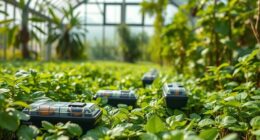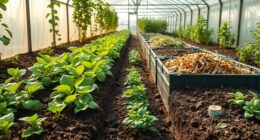School gardens can ignite creativity and a love for nature in students, making learning exciting. Resources like "The School Garden Curriculum" and "The Garden Classroom" integrate hands-on gardening with various subjects, fostering teamwork and critical thinking. "How to Grow a School Garden" offers practical steps for parents and teachers, while "Its Our Garden" showcases community engagement and sustainable practices. There's so much more about these transformative spaces, so let's explore some amazing school gardens together.
Key Takeaways
- School gardens provide hands-on learning experiences, enhancing students' appreciation for nature and healthy eating habits.
- Community involvement strengthens ties and fosters ownership among students, encouraging teamwork and social skills.
- Incorporating diverse gardening techniques, like companion planting and seasonal schedules, enriches students' understanding of ecosystems and growth cycles.
- Accessible garden designs ensure all students, including those with disabilities, can participate and engage in gardening activities.
- Celebrating harvests promotes social engagement and highlights local food systems, creating a vibrant community learning environment.
The School Garden Curriculum: An Integrated K-8 Guide
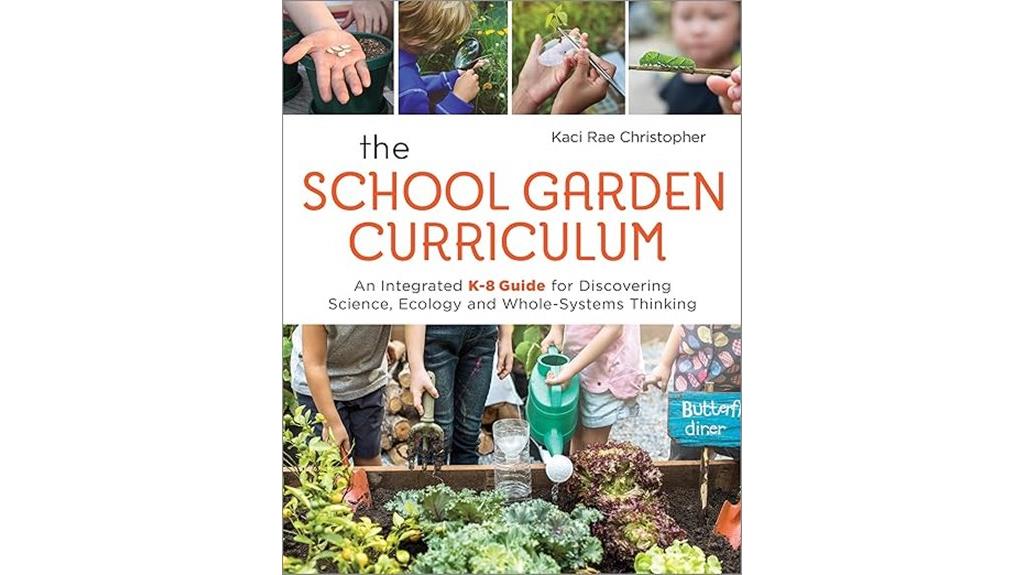
The School Garden Curriculum: An Integrated K-8 Guide is perfect for educators and parents who want to inspire a love for gardening in children. This extensive resource offers a wealth of information and creative ideas, making it ideal for various educational settings, like school garden clubs and co-ops. I've found it particularly helpful for engaging kids in science and ecology through hands-on activities. However, it's worth noting that the book assumes some prior gardening knowledge, which might pose a challenge for beginners. Overall, I highly recommend it for anyone looking to foster a connection between children and nature through gardening.
Best For: Educators and parents seeking to inspire children's love for gardening through hands-on learning experiences.
Pros:
- Offers a comprehensive approach to teaching gardening concepts suitable for various educational settings.
- Provides a wealth of creative ideas and information to engage children in science and ecology.
- Highly recommended by users for its potential to foster a connection between children and nature.
Cons:
- Assumes foundational knowledge of gardening, which may challenge beginners.
- Lacks accompanying worksheets and resources, requiring additional time to find supplementary materials.
- Some users express disappointment over the need to pay for access to complete resources online.
Its Our Garden: From Seeds to Harvest in a School Garden
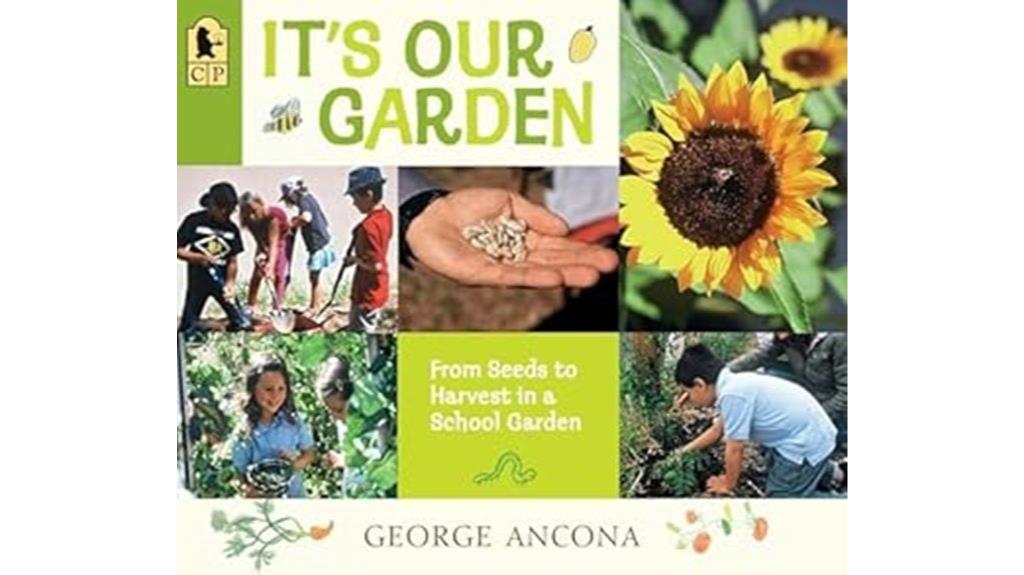
If you're looking to foster a love for gardening in young minds, "Its Our Garden: From Seeds to Harvest in a School Garden" is your go-to resource. This book showcases how an elementary school in Santa Fe engages kids in garden maintenance, with community support even during breaks. It highlights traditional techniques like the three sisters garden, making gardening educational for everyone involved. The celebration of harvests, complete with community gatherings and pizza made in a student-built oven, beautifully illustrates the joy of teamwork. I found it inspiring, sparking ideas to enhance community involvement in school gardens everywhere.
Best For: This book is best for educators, parents, and community members looking to enhance children's gardening experiences and promote sustainable practices in school settings.
Pros:
- Engages students in hands-on gardening activities, fostering a love for nature and healthy eating.
- Encourages community involvement, allowing parents and volunteers to participate in garden maintenance and celebrations.
- Showcases traditional gardening techniques, providing educational value and cultural insights, such as the three sisters garden.
Cons:
- May have limited applicability for schools without sufficient outdoor space or resources for gardening.
- Some readers may find certain gardening techniques challenging to implement without guidance.
- Focuses primarily on one school's experience, which may not reflect the diverse needs of all schools or communities.
How to Grow a School Garden: A Complete Guide for Parents and Teachers
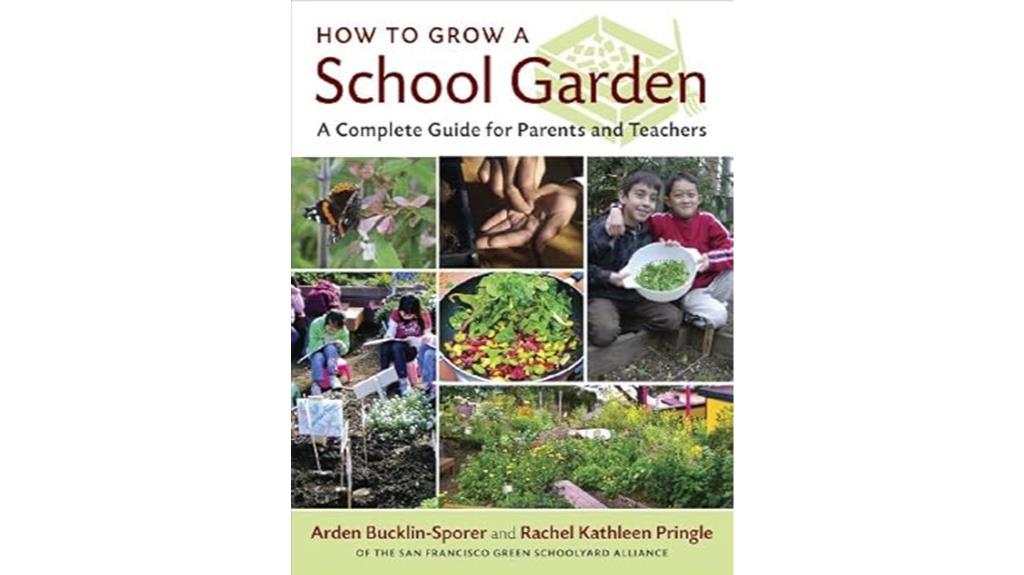
Looking to create a thriving school garden? I've found an incredible guide that makes the process enjoyable and straightforward for parents and teachers alike. This book covers everything from fundraising to planting, making it easy to integrate the garden into your curriculum. You'll love the hands-on learning chapters, which teach kids about food sources and the benefits of gardening. Plus, it emphasizes community support, helping you rally parents and volunteers. With practical resources and a weekly schedule, you'll feel confident starting or enhancing your school garden. Trust me, this guide is a must-have for your gardening journey!
Best For: Parents and teachers looking to create or enhance a school garden through practical guidance and community engagement.
Pros:
- Engaging and Informative: The book is easy to read and enjoyable, encouraging readers to fully engage with the content.
- Hands-on Learning: It provides valuable chapters on integrating gardening into the curriculum, enhancing children's understanding of food sources.
- Comprehensive Resources: Offers step-by-step instructions and a wealth of activities, making it a practical tool for educators and volunteers.
Cons:
- Regional Limitations: Some strategies may be less applicable to specific climates, requiring adaptation.
- Volunteer Dependence: Success may heavily rely on the availability and commitment of community volunteers.
- Initial Investment: Fundraising and initial setup may pose challenges for some schools with limited resources.
The Garden Classroom: Hands-On Activities in Math, Science, Literacy, and Art
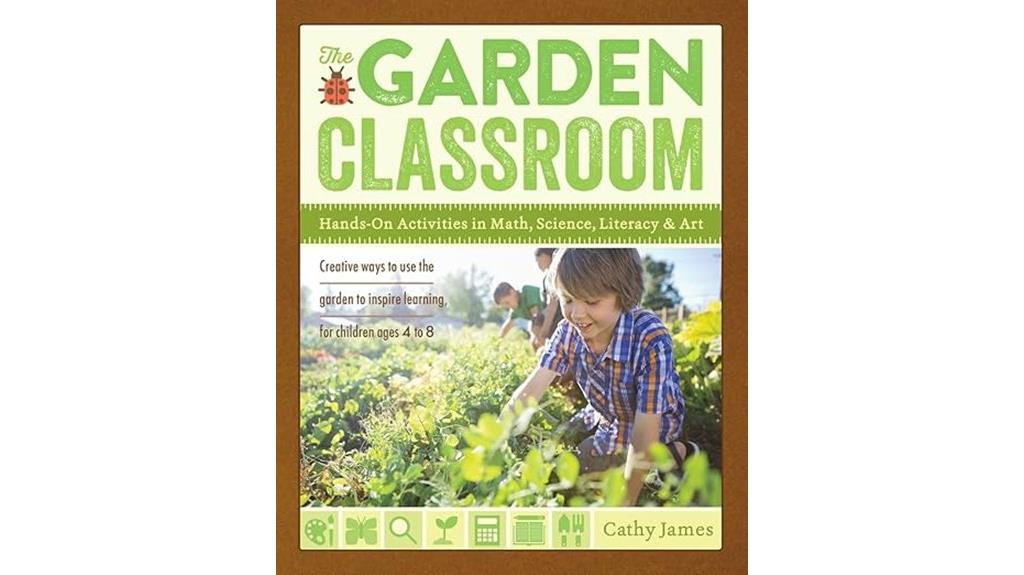
For educators seeking engaging ways to integrate hands-on learning into their curriculum, "The Garden Classroom" stands out as an invaluable resource. It offers fun and easy-to-follow activities in math, science, literacy, and art, perfect for preschool through grade 6. I've found its grab-and-go lesson plans incredibly adaptable for various teaching settings, whether in classrooms or homeschooling. The emphasis on gardening not only promotes healthy eating but also fosters a love for nature. With creative projects that keep kids engaged outdoors, this book truly inspires learning. I highly recommend it to anyone looking to enhance their educational toolkit with garden-based activities!
Best For: Educators and parents looking for engaging, hands-on activities that integrate gardening with math, science, literacy, and art for children from preschool to grade 6.
Pros:
- Provides adaptable, grab-and-go lesson plans suitable for various teaching environments, including homeschooling and classrooms.
- Encourages healthy eating habits by teaching children how to grow their own food, fostering a love for nature.
- Features a variety of creative and fun projects that keep children engaged in outdoor learning.
Cons:
- Some users wish they had discovered the resource earlier in the school year, indicating it may not be as effective if introduced late.
- The focus on gardening may not appeal to all educators or students, limiting its applicability for some curriculum topics.
- While the activities are diverse, some users may find certain projects less relevant to their specific educational goals.
Our School Garden!

Our school garden is a vibrant hub of creativity and learning, perfect for educators enthusiastic to engage students in hands-on experiences. I love how the garden invites everyone—kids, parents, and even grandparents—to participate. With practical examples from our resource book, I've seen how gardening can transform lessons in STEM subjects. The charming illustrations breathe life into the pages, making the history of school gardening come alive. For families in urban areas, it's a great way to connect with nature, even on a terrace. Our garden isn't just a space; it's a community where learning flourishes.
Best For: Families, educators, and students looking to engage in hands-on learning through gardening activities.
Pros:
- Encourages hands-on learning and creativity in STEM subjects.
- Suitable for a wide audience, including kids, parents, and educators.
- Provides valuable gardening insights for urban families with limited space.
Cons:
- May require additional resources or space for implementation in some schools.
- Some families might find it challenging to maintain a garden due to time constraints.
- Limited focus on specific gardening techniques for advanced gardeners.
The English Gardening School: Complete Master Course on Garden Planning and Landscape Design

If you're an American gardener enthusiastic to plunge into the intricacies of garden planning and landscape design, "The English Gardening School: Complete Master Course" is an ideal choice. This course, highly recommended by a landscape designer, offers engrossing content that's applicable across various U.S. locations. It's tailored for both beginners and those with some experience, focusing on essential design concepts and landscape principles. While it primarily emphasizes formal garden styles, like country house gardens with clipped hedges and fountains, it provides invaluable insights from a respected English author. You'll find this course a fantastic resource for honing your gardening skills!
Best For: American gardeners who are beginners or have some experience and want to learn about garden planning and landscape design.
Pros:
- Provides fundamental design concepts and techniques applicable to various U.S. locations.
- Highly recommended by a landscape designer, ensuring quality and credibility.
- Offers valuable insights from a respected English author known for cultivating skilled gardeners.
Cons:
- Primarily focuses on formal garden styles, which may not appeal to those interested in alternative styles.
- Limited specific plant recommendations, particularly for regions like Southern California.
- The theoretical nature of the advice may be more directed towards professionals than casual gardeners.
In Our Garden

School Gardens is perfect for young readers who crave inspiration and connection to nature. In "In Our Garden," I felt a deep connection with Millie, a young girl who struggles to adjust after moving to a stark, concrete environment. Her longing for the colors of her old rooftop garden ignited a passion in me. Millie's determination to create a vibrant school garden, despite skepticism, highlights the power of community. Together, her classmates, teachers, and neighbors transform a neglected space into a flourishing garden. This story beautifully illustrates resilience, teamwork, and the magic of nature, inspiring us all to dream and take action.
Best For: "In Our Garden" is best for young readers who seek inspiration and a connection to nature through storytelling.
Pros:
- Encourages resilience and teamwork by showcasing the importance of community involvement in achieving a common goal.
- Beautiful illustrations that enhance the emotional impact of the story and engage young readers visually.
- Promotes environmental awareness and the idea of transforming neglected spaces into vibrant, life-filled areas.
Cons:
- May be too simplistic for older readers or those seeking more complex narratives.
- Potentially limited appeal for children who are not interested in gardening or nature themes.
- Some readers may find the pacing slow as it focuses on Millie's journey and community collaboration.
Insect Lore Butterfly Garden Home School Kit

The Insect Lore Butterfly Garden Home School Kit is perfect for parents and educators looking to engage children in a hands-on learning experience about the life cycle of butterflies. I love that it includes a live cup of 5 Painted Lady caterpillars, allowing us to observe their metamorphosis over three weeks. The ultra-clear observation dome makes it easy to see every stage, while the STEM-focused butterfly journal provides fun activities in science, math, and writing. With guaranteed butterfly emergence and a thorough guide, this kit not only sparks curiosity but also fosters a deeper appreciation for nature's wonders.
Best For: Parents and educators seeking an interactive and educational experience for children to learn about butterfly metamorphosis.
Pros:
- Engaging hands-on project that teaches children about the life cycle of butterflies.
- Includes a STEM-focused butterfly journal with various educational activities.
- Guaranteed butterfly emergence, ensuring a successful learning experience.
Cons:
- Shipping restrictions limit availability to certain locations.
- Some customers have reported challenges with caterpillar survival.
- Experience may vary, with not all users achieving the expected number of butterfly emergences.
Insect Lore Butterfly Garden – Pavilion School Kit
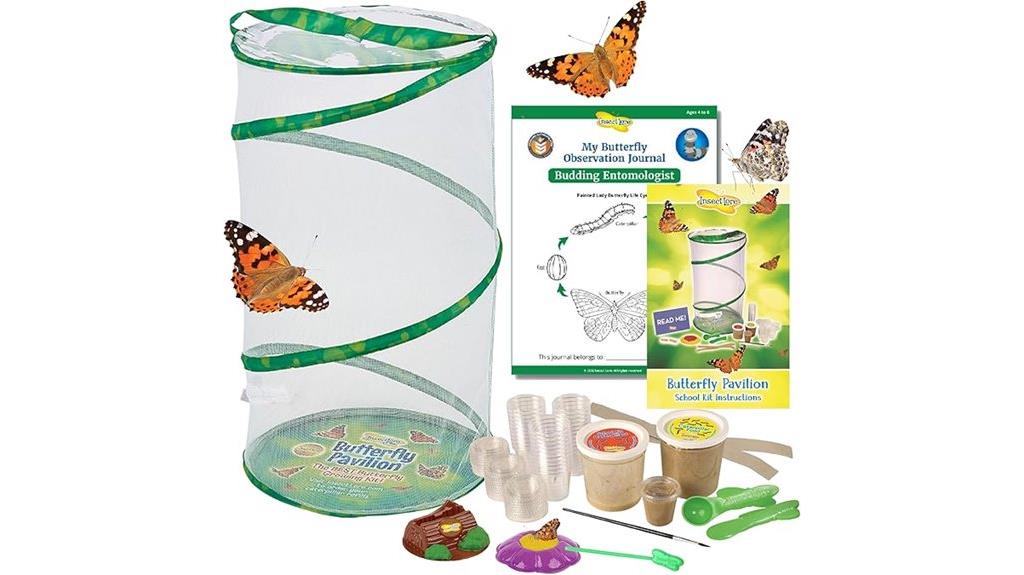
Designed specifically for educators and students, the Insect Lore Butterfly Garden – Pavilion School Kit offers a hands-on STEM learning experience that captivates and engages young minds. With 33 live caterpillars and individual two-ounce cups, each student can care for their own caterpillar, making the lessons even more personal. The kit includes nutritious food, a STEM journal filled with activities, and essential tools for a thorough exploration of the butterfly life cycle. While some users report challenges with caterpillar mortality, the excitement of watching these creatures grow often outweighs the setbacks. It's truly a magical experience for any classroom!
Best For: Educators and students seeking an interactive and engaging STEM experience focused on the butterfly life cycle.
Pros:
- Hands-on learning with individual caterpillar care enhances student engagement and personal connection.
- The kit includes a variety of components such as a STEM journal and necessary tools for a comprehensive educational experience.
- Positive student excitement and successful caterpillar growth contribute to a memorable classroom activity.
Cons:
- Some users report high mortality rates among caterpillars, leading to disappointment.
- Issues with missing or broken items in the kit can affect the overall experience.
- Temperature restrictions may delay shipping, limiting accessibility in certain regions.
Mrs. Spitzers Garden: [Gift Edition]
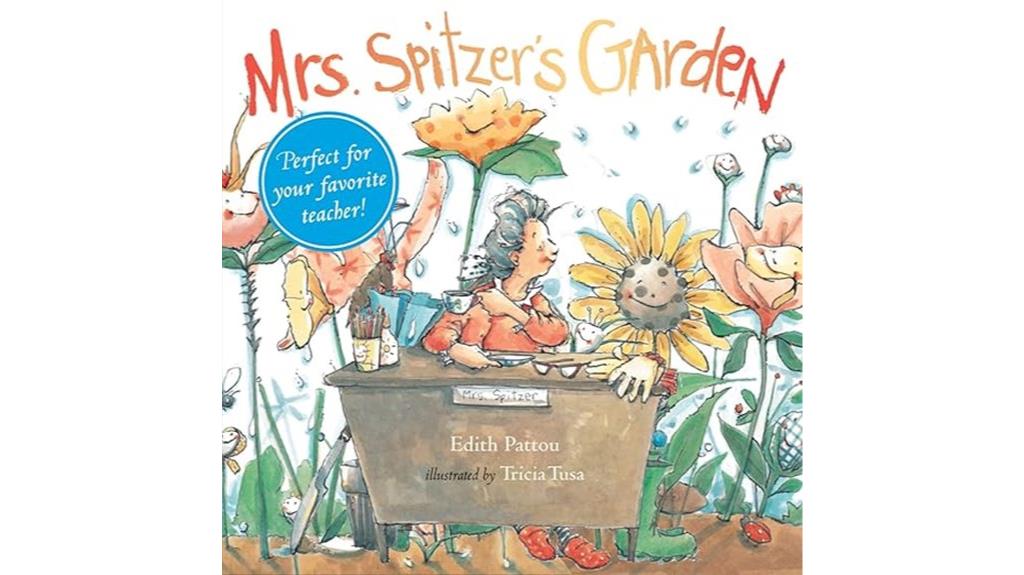
For those looking for a heartfelt gift for a teacher, "Mrs. Spitzer's Garden" is simply perfect. This charming story beautifully illustrates the nurturing relationship between a teacher and her students, likening them to seeds growing into vibrant flowers. I've seen firsthand how touching this book can be; one teacher even cried upon receiving it! Pair it with a potted plant or gift card for an extra special touch. Its heartfelt message resonates deeply, especially among kindergarten and preschool educators. Plus, the option for a personal note inside makes it a thoughtful keepsake that truly shows appreciation for their dedication.
Best For: This book is best for teachers, particularly those working with young children, as a heartfelt gift that symbolizes their nurturing role.
Pros:
- The story beautifully illustrates the teacher-student relationship, making it relatable and meaningful.
- It can be paired with a potted plant or gift card for a thoughtful presentation.
- The option for a personal note inside adds a special touch and allows for customization.
Cons:
- Some readers prefer larger, non-hardcover versions for better visibility of the illustrations.
- The emotional impact may not resonate as strongly with all educators, depending on personal preferences.
- The specific theme may not appeal to teachers of older students or different subjects.
Factors to Consider When Choosing School Gardens

When I think about choosing a school garden, I consider several key factors that can really impact the experience. The educational value and how it fits into our curriculum stand out, along with the importance of community involvement. It's also essential to think about accessibility for all students and how we'll maintain the garden sustainably.
Educational Value and Curriculum
While considering the implementation of school gardens, it's crucial to recognize their significant educational value. School gardens offer hands-on learning experiences that engage students across subjects like science, math, literacy, and art. I've seen firsthand how gardening activities deepen students' understanding of ecosystems and food sources, nurturing their appreciation for nature and healthy eating. Structured lesson plans link garden tasks to educational standards, making learning relevant and applicable. Collaborative gardening projects not only promote teamwork but also foster social skills and a sense of belonging. Through practical tasks, students develop critical thinking, problem-solving abilities, and patience. Fundamentally, school gardens serve as vibrant classrooms, enriching the educational experience while connecting students to the world around them.
Community Involvement Benefits
Community involvement in school gardens not only enriches the learning experience but also cultivates a strong sense of ownership among students. When parents and local volunteers pitch in, it strengthens community ties and brings in valuable resources for educational initiatives. I've seen how collaborative gardening projects promote teamwork and enhance communication skills as students work together toward shared goals. This collective effort also attracts community support, which can lead to increased funding and improved sustainability of our gardening programs. Plus, celebrating harvests and garden events with the community fosters social engagement and showcases the benefits of local food systems. It's heartwarming to witness how a garden can bring everyone together, creating lasting memories and connections.
Gardening Techniques and Practices
Choosing the right gardening techniques and practices for school gardens can transform the educational experience for students. I've found that incorporating traditional methods, like the three sisters technique, not only promotes biodiversity but also teaches valuable historical lessons. Hands-on gardening activities enhance learning in subjects like science and math, giving students practical applications for what they study. By utilizing strategies such as companion planting, we can improve crop yields and understand ecosystems better. Regular maintenance tasks—like weeding, watering, and harvesting—instill a sense of responsibility and appreciation for food production. Finally, implementing seasonal planting schedules helps students grasp growth cycles and adapt to local climate conditions, making gardening a dynamic and engaging learning experience.
Accessibility for All Students
Creating an inclusive school garden means considering accessibility for all students right from the start. To guarantee everyone can participate, I prioritize features like raised beds and appropriate tools for students with disabilities. I also make certain the pathways are wide enough for wheelchairs and mobility devices, allowing easy movement throughout the garden.
Additionally, I design educational materials and activities to cater to diverse learning styles and language proficiencies, engaging every student effectively. Incorporating sensory experiences with plants that have varying textures, colors, and scents is essential, especially for those with sensory processing differences. Collaborating with occupational therapists and special education professionals helps me create a garden that truly meets the needs of all students, fostering a welcoming and inclusive environment.
Maintenance and Sustainability Plans
While establishing a school garden can be an exciting endeavor, effective maintenance and sustainability plans are essential for ensuring its long-term success. I believe creating a maintenance schedule for watering, weeding, and harvesting is vital. Involving students and community volunteers not only helps with upkeep but also fosters a sense of ownership. Choosing native and drought-resistant plants can greatly cut down on water usage and lower maintenance efforts. Additionally, implementing composting practices enriches the soil while reducing waste. Finally, a clear sustainability plan should include strategies for seasonal crop rotation to maintain soil health and productivity. By considering these factors, we can create a thriving garden that inspires learning and creativity for years to come.
Frequently Asked Questions
What Are the Benefits of School Gardens for Student Mental Health?
I've seen firsthand how school gardens benefit student mental health. Being outside and working with plants reduces stress and anxiety, creating a calming space. It's amazing how tending to a garden fosters a sense of accomplishment and boosts self-esteem. I've noticed students opening up more and forming friendships while collaborating on gardening projects. These experiences not only improve their mood but also teach them valuable life skills that extend beyond the classroom.
How Can School Gardens Be Funded or Supported?
Funding school gardens can be like planting seeds in fertile soil; with the right support, they flourish. I've found that reaching out to local businesses for donations or partnerships works wonders. Grants from educational foundations also provide valuable resources. Don't underestimate community fundraisers, either; they can rally support while fostering a sense of ownership. By encouraging volunteer efforts, we can cultivate not just gardens, but a strong sense of community around them.
What Challenges Do Schools Face When Starting a Garden?
Starting a school garden can be tough. I've seen schools struggle with limited funding, which makes it hard to purchase materials and plants. There's also the challenge of finding enough volunteers—teachers and parents often juggle busy schedules. Plus, weather can be unpredictable, affecting planting and maintenance. It's essential to have a solid plan and gather support from the community to tackle these challenges head-on, ensuring the garden thrives for everyone to enjoy.
Are There Specific Plants That Work Best in School Gardens?
When I think about specific plants that work best in school gardens, I often lean towards easy-to-grow options like herbs, radishes, and sunflowers. These plants thrive in various conditions and allow students to see quick results. Plus, they're engaging and can be integrated into lessons across subjects. I've found that incorporating seasonal vegetables like tomatoes or peppers also excites kids about healthy eating and the importance of sustainability.
How Can Parents Get Involved in School Garden Projects?
When I first joined my child's school garden project, it felt like stepping into a vibrant tapestry of colors and life. To get involved, I started by attending meetings and volunteering for planting days. I also reached out to other parents, sharing ideas and resources. It's amazing how a shared commitment can turn a plot of land into a thriving community space. Together, we can nurture not just plants, but our children's love for nature.
Conclusion
In my journey through these incredible school gardens, I stumbled upon something unexpected: the profound impact they have on our children's creativity and learning. Just when I thought I'd seen it all, a butterfly flitted by, reminding me how nature can spark curiosity and joy. If you've ever felt a spark of inspiration, it's likely these gardens will ignite the same in your little ones. Let's dig in and watch them bloom—after all, you never know what wonders await!






